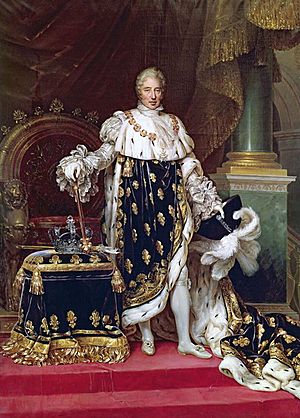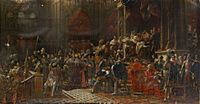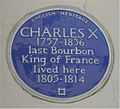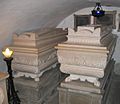Charles X of France facts for kids
Quick facts for kids Charles X |
|||||
|---|---|---|---|---|---|

Charles X, strong believer of Absolutism
|
|||||
| King of France and of Navarre | |||||
| Reign | 16 September 1824 – 2 August 1830 | ||||
| Predecessor | Louis XVIII | ||||
| Successor | Louis Philippe I | ||||
| Born | 9 October 1757 Palace of Versailles, France |
||||
| Died | 6 November 1836 (aged 79) Paris, France |
||||
| Burial | Kostanjevica Monastery, Nova Gorica, Slovenia | ||||
| Spouse | Marie Therese of Savoy | ||||
| Issue | Louis Antoine, Duke of Angoulême Charles Ferdinand, Duke of Berry |
||||
|
|||||
| Father | Louis, Dauphin of France | ||||
| Mother | Marie Josephe of Saxony | ||||
Charles X (1757-1836), king of France and Navarre (1824-30). He was the grandson of Louis XV and younger brother of kings Louis XVI and Louis XVIII. Charles was known as Charles Philippe, Count of Artois, until he became king. During the French Revolution he was one of the leaders of the émigrés. Note, however, that the family name remained "d'Artois" even when he used the name "Bourbon."
Contents
Early Life
Charles-Philippe was born in 1757, the youngest son of the Dauphin Louis Ferdinand, and his wife, the Dauphine Marie Josèphe, at the Palace of Versailles. Charles was named comte d'Artois at birth by his grandfather, the reigning King Louis XV. As the youngest male in the family Charles seemed unlikely ever to become king.
Charles' father died in 1765, which left Charles' oldest surviving brother, Louis Auguste (the later Louis XVI), to succeed their father in the capacity of Dauphin, the French equivalent to a crown prince or heir apparent. Charles' mother, Marie Josèphe, never recovered from the loss of her husband and she died in March 1767 from tuberculosis. This left Charles an orphan at the age of nine.
Throughout the 1770s, Charles spent lavishly. He accumulated enormous debts (they totalled 21 million livres), which Louis XVI paid for him in the early 1780s. Their brother the comte de Provence also accumulated debts of a similar magnitude, which Louis XVI also paid off.
His political awakening started with the first great crisis of the monarchy in 1786, after which he headed the reactionary faction at the court of Louis XVI. The comte d'Artois supported the removal of the aristocracy's financial privileges, but was opposed to any reduction in the social privileges enjoyed by both the Church and the nobility.
During and After the French Revolution
When the French Revolutionary Wars broke out in 1792, Charles escaped to Great Britain. King George III of Great Britain welcomed the comte d'Artois warmly, and gave him a generous allowance. He lived in Edinburgh and London with his mistress Louise de Polastron. After the accession (1814) of Louis XVIII to the French throne, Charles returned to France, where he headed the ultraroyalist party of reaction.
King of France
Charles' first act as King of France was to grant the style of Royal Highness to his cousins of the cadet branch of the House of Bourbon, the Orléans. Because the Duke of Orleans had voted the death of his brother Louis XVI, Louis XVIII had greatly disliked the Orléans family. However, Charles intended it to create a unified House of Bourbon.His favoritism during his reign toward the Roman Catholic Church and the aristocracy aroused great opposition, leading to the revolution of July 1830.
July Revolution
Charles X is a strong believer in absolutism and rejected the Charter of the French Liberties, which is issued by his predecessor and brother Louis XVIII. In July 1830, he suspended the legislature, limited the right to vote, and restricted the press. Liberals and radicals responded forcefully to the absolute king. In Paris, angry citizens threw up barricades across the narrow streets. Others fired the soldiers and throw stones and roof tiles. The revolutionary tricolor flew from the towers of Notre Dame cathedral. Charles was forced to abdicate. He again went into exile in Britain. He was succeeded by his cousin, Louis-Philippe, son of the Duke of Orleans who had supported the French Revolution.
Death
Charles caught cholera when he arrived in Gorizia, Italy. He died on November 6 1836. The townspeople draped their windows in black to mourn him. Charles was buried in the Church of the Annunciation of Our Lady, in the Franciscan Kostanjevica Monastery (now in Nova Gorica, Slovenia).
Marriage and issue
Charles X married Princess Maria Teresa of Savoy, the daughter of Victor Amadeus III of Sardinia and Maria Antonia of Spain on 16 November 1773. The couple had four children:
- Louis Antoine, Duke of Angoulême (6 August 1775 – 3 June 1844) Louis Antoine d'Artois
- Sophie d'Artois (5 August 1776 – 5 December 1783) Sophie d'Artois
- Charles Ferdinand d'Artois, Duke of Berry (24 January 1778 – 13 February 1820) Charles Ferdinand d'Artois
- Marie Thérèse d'Artois (1783)
Images for kids
-
A Blue plaque at 72 South Audley Street, Mayfair, London, his home between 1805 and 1814
-
Tombs of Charles X and his son Louis at the Kostanjevica Monastery in the Slovenian town of Nova Gorica
See also
 In Spanish: Carlos X de Francia para niños
In Spanish: Carlos X de Francia para niños










